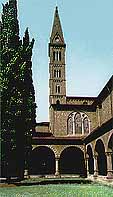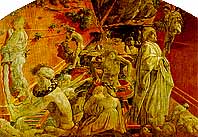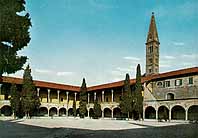
The Green Cloister
The entrance to the Council Museum of Santa Maria Novella, which also includes the three Monumental Cloisters and the great Spanish Chapel, can be found on the left of the facade. The first and oldest are the Green Cloisters, built in Romanesque-Gothic style and completed after 1350. The lunettes between the arches are frescoed with Stories from the Old Testament in green and reddish colours (from which it takes its name) and were carried out by Paolo Uccello and his pupils, among them Dello di Niccolò Delli, in around 1430.

P.Uccello,
the Deluge
Paolo Uccello is known to have personally painted the lunettes on the right beside the Basilica with the Stories of Noah: the Flood in particular is a real masterpiece. The cloister contains the entrance to the convent's Chapter House, which was called the Spanish Chapel after the Duchess Eleonora of Toledo assigned it to the gentlemen in her retinue as a place of worship in 1566. The architectural design was carried out by Fra Iacopo Talenti (1350-55); the frescoes decorating the walls were created around the theme of the glorification of the Dominican Order and represent painter Andrea di Bonaiuto's most famous work (1365-67).

The Big Cloister
The Green Cloister leads into the Cloister of the Dead, which contains numerous chapels and frescoes of 14th century Florentine school (Maso di Banco, Iacopo del Casentino, Orcagna...) and tomb stones from all periods. Here one can also find the tomb of Quirina Magiotti Mocenni (1847), who was so beloved and celebrated by the poet Ugo Foscolo. A window in the passage that leads from the Green Cloister to the Museum gives a view of the Great Cloister, with its 56 round-headed arches, built between 1340 and 1360. The walls are decorated with stories of Dominican saints, painted between the late 16th and the early 17th centuries by some of the finest artists at the Medici court: Bronzino, Poccetti, Cigoli and Santi di Tito. This part of the convent, including the Chapel of the Popes, can only be visited by appointment as it is in the part of the building occupied by the Carabinieri Officer's School.
The entrance to the Council Museum of Santa Maria Novella, which also includes the three Monumental Cloisters and the great Spanish Chapel, can be found on the left of the facade. The first and oldest are the Green Cloisters, built in Romanesque-Gothic style and completed after 1350. The lunettes between the arches are frescoed with Stories from the Old Testament in green and reddish colours (from which it takes its name) and were carried out by Paolo Uccello and his pupils, among them Dello di Niccolò Delli, in around 1430.
